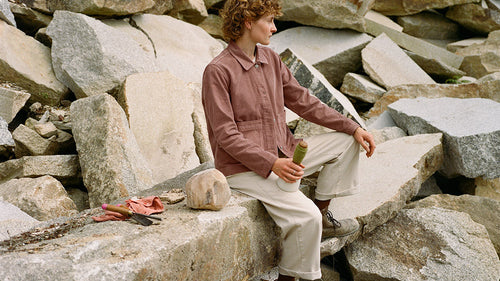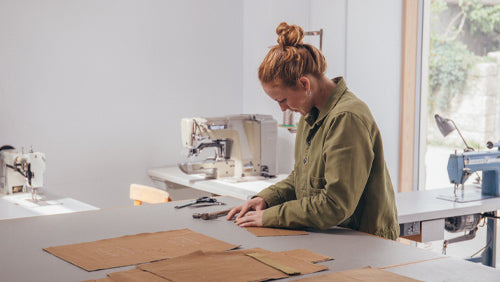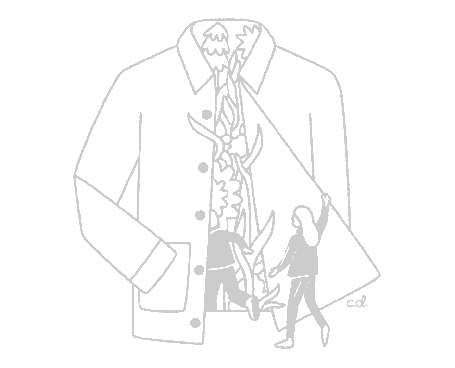Just like our Batch No.19 overcoat, this story of how it came to be is a long one. Read on below for Part 1 of the development of our coat, and why we decided to work with the only fabric in the world to be protected by law - Harris Tweed.
Part 1: The Island.
For years, we have wanted to make a long wool coat. A coat made from a classic hardwearing wool herringbone that's bursting with character, will get better with age and won't go out of style.
It's a big ask.
We started with the most important ingredient, the fabric. We sampled with Portuguese wools, then started working with Italian mills. But nothing we saw was quite right.
They were often a little too flat. Or, on the other end of the scale, too bold. There was a depth of character that was lacking, and we couldn't stop comparing them to the 'dream option'.

The Dream Fabric.
Woven by British luxury artisan mill that we'd never worked with before, their fabrics were more than twice the price and took longer to make compared to all the other options we'd looked at previously.
But when the fabric swatches arrived, we flicked through the collection one by one, and we decided to throw our budget out the window.
We couldn't stop comparing all the other option to theirs. Nothing came close.
We probably won't be making this coat for another three or four years, so we might as well use the best of the best.
These cloths were hand woven with yarns that were unbelievably rich in colour and character. Plus, they were an ideal weight to keep you warm while draping beautifully.
An Iconic Mill.
To learn how these beautiful fabrics were made, we took an overnight sleeper train up to Scotland, followed by a flight in a tiny plane to the Outer Hebrides, 24 miles off the west coast of Scotland, to visit the makers of this incredible fabric - Harris Tweed Hebrides.

The Isle of Harris and Lewis.
A single island divided by mountains and part of the Outer Hebrides - home to every weaver, dyer, blender, carder, spinner, warper, finisher and inspector of Harris Tweed.
The landscape there is wild and rugged, and hidden away are some of the most beautiful and remote beaches in the world. We explored every long and winding single-track road we came across. All the while experiencing every season in a single day.
Exploring the island, you see the colours in the landscape that are woven into the fabric. The mossy greens, the browns of the bark, the turquoise blue sea, the purple heather, and cloudy grey sky. The natural hues are identical to those in the cloth. This landscape didn't just inspire the colours of the cloth. This is a soft yet hardy wool, designed to withstand the unpredictable coastal climates of Northern Scotland.
Like Champagne or Parma Ham, the process of making Harris Tweed is protected by law.
It's the only fabric in the world to be protected by an Act of Parliament, and the fabric must be made by following some strict rules:
Rule #1 - It must be produced in the Outer Hebrides of Scotland.
Rule #2 - It must be made from 100% pure new wool.
Rule #3 - It must be handwoven in the weaver's home.
That's right. It's not woven in a large industrial building using automated machines, but by hand in a weavers home. Just as it was done over a hundred and fifty years ago.
The Fabric of a Community.
Harris Tweed is a reflection of the island: the colours, the community, and a total commitment to craft.
Although Harris Tweed is often imitated, it is never duplicated. Harris Tweed belongs to the islands and its people.
Once finished, each meter of this beautifully intricate cloth is checked and authenticated with the Orb trademark.

Handwoven.
When Harris Tweed cloth was first woven in around 1840, some weavers had no electricity. The looms were powered only by the weaver's legs. To keep that tradition to this day, there must be no electricity or automation used to weave this cloth.
We visited Ian, a weaver, crofter and part time fireman, and he showed us how he powers the loom, just like he's riding a bike.
With the click, clack of the loom, Ian's eyes were locked on the fabric, looking over every inch as its woven, gently running his hands over the fabric as it comes off the loom.
It's a painstakingly slow process and a true labour of love—a skill handed down from generation to generation.
The process of making this world-renowned fabric hasn't changed in over a century.

A Natural Beauty.
To achieve the sought after character in their fabric they blend multiple different colours of wool to make a single yarn.
As we found out in the mill, a brown cloth isn't made from a brown yarn.
Starting with a white pure new wool, Harris Tweed Hebrides dye so many colours to exacting recipes, then create yarn with a number of those different colours within each strand.
A brown yarn is made with reds, blues, greens, whites, yellows, blacks and brown.
And even once a yarn is twisted and the fabric is woven, all those original flecks of colour remain visible. That is what gives Harris Tweed a depth of character like no other.
The fabric changes in different lights, bringing out its unique colours and character.
During our visit to the mill, we saw the wool being dyed, blended and made into the yarn that was used to make our Penny Brown Herringbone:



Our selection.
Harris Tweed has some vibrant and colourful patterns to choose from, but for our long wool overcoat, we chose a timeless and sophisticated selection of colours...
1, Penny Brown - Made with a blend of earthy browns, reds, blues, blacks and greens.
2, Graphite - Made with blacks, charcoals, mossy greens and cloudy greys.
3, Deep Navy - Made with a blend of rich blues and blacks.
Each one is full of character and woven to Harris Tweed's exacting standards.



Batch No.19.
For months, 14 home weavers worked on the production of our fabric for Batch No.19, and with the Harris Tweed Authority's beeswax seal of quality on every roll of fabric, it's now on the road and not far off arriving in our factory
We can't wait to share more about the style of our coat next week in Part Two.
And on Friday, the 27th of September, we’ll be giving newsletter subscribers early access to Batch No.19.



